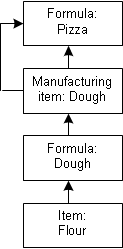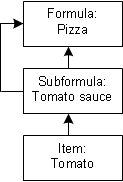Indirectly nesting and directly nesting of formulas
You can indirectly nest a subformula by adding a manufacturing item in a formula.

You can directly nest a sub-formula in a formula.

This table shows the benefits of indirect and direct nesting:
| Indirect Nesting Benefits | Direct Nesting Benefits |
|---|---|
| Items can have several possible
formulations. You assign one of them to be the master formula to be used in
production.
When you add this type of item to a parent formula, the associated master formula is brought into the parent formula. To change the designation of the master formula for the item, all parent formulas are updated with the newly designated master formula. You can add manufacturing items as byproducts to a formula. Perform rollup on formulas containing manufacturing items. Group manufacturing items in an ingredient statement. Write Guidelines and Restrictions statements for manufacturing items. Transfer of data to external systems, like an ERP system, can require use of manufacturing items. |
You add one specific subformula to a parent
formula.
To replace the subformula, you open each parent formula to do so. Benefits include:
|